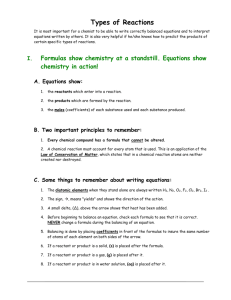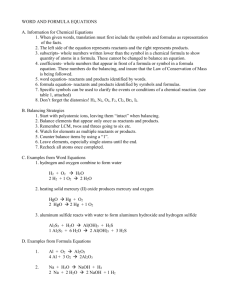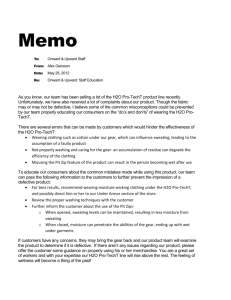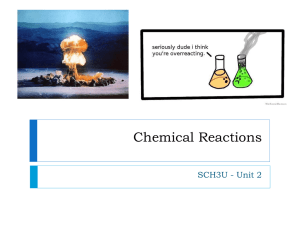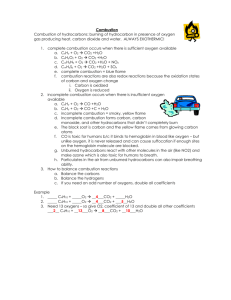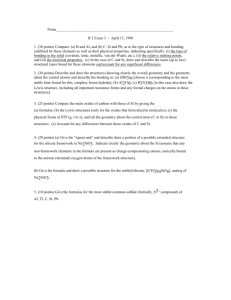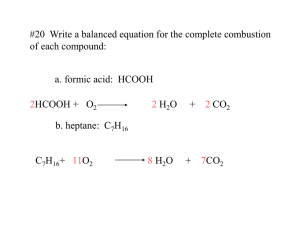Classification of Reactions
advertisement
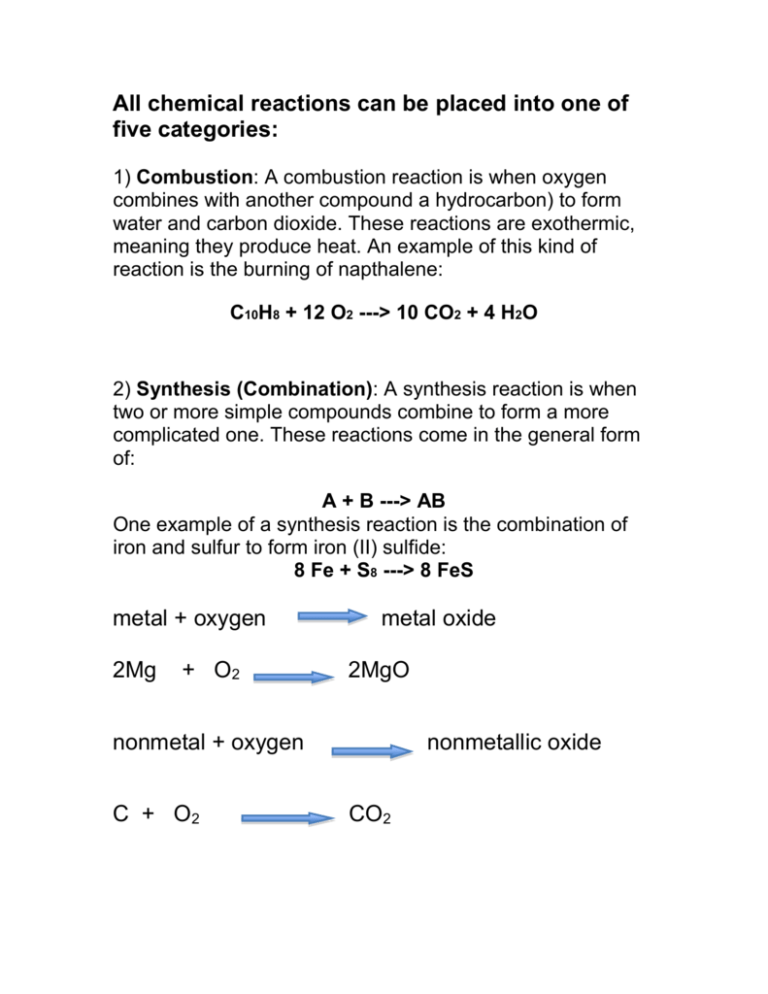
All chemical reactions can be placed into one of five categories: 1) Combustion: A combustion reaction is when oxygen combines with another compound a hydrocarbon) to form water and carbon dioxide. These reactions are exothermic, meaning they produce heat. An example of this kind of reaction is the burning of napthalene: C10H8 + 12 O2 ---> 10 CO2 + 4 H2O 2) Synthesis (Combination): A synthesis reaction is when two or more simple compounds combine to form a more complicated one. These reactions come in the general form of: A + B ---> AB One example of a synthesis reaction is the combination of iron and sulfur to form iron (II) sulfide: 8 Fe + S8 ---> 8 FeS metal + oxygen 2Mg + O2 metal oxide 2MgO nonmetal + oxygen C + O2 nonmetallic oxide CO2 Metallic oxide + water metallic hydroxide MgO + H2O Mg(OH)2 Nonmetallic oxide + water CO2 + H2O Metal + 2Na + Cl2 acid H2CO3 nonmetal salt 2 NaCl A few nonmetals combine with each other. 2P + 3Cl2 2PCl3 3) Decomposition: A decomposition reaction is the opposite of a synthesis reaction - a complex molecule breaks down to make simpler ones. These reactions come in the general form: AB ---> A + B One example of a decomposition reaction is the electrolysis of water to make oxygen and hydrogen gas: 2 H2O ---> 2 H2 + O2 metallic carbonates when heated form metallic oxides and CO2. CaCO3 CaO + CO2 Most metallic hydroxides when heated decompose into metallic oxides and water Ca(OH)2 CaO + H2O Metallic chlorates when heated decompose into chlorides and oxygen. 2KClO3 2KCl + 3O2 Some acids when heated decompose into nonmetallic oxides and water. H2SO4 H2O + SO3 Some oxides when heated decompose. 2HgO 2Hg + O2 Some products are unstable and break down as they are produced during a reaction: H2CO3 (aq) H2O (l) + CO2 (g) Carbonic acid decomposes when it is formed. H2SO3 (aq) H2O (l) + SO2 (g) Sulfurous acid also decomposes as it is formed. NH4OH (aq) NH3 (g) + H2O (l) 4) Single displacement: This is when one element trades places with another element in a compound. These reactions come in the general form of: A + BC ---> AC + B One example of a single displacement reaction is when magnesium replaces hydrogen in water to make magnesium hydroxide and hydrogen gas: Mg + 2 H2O ---> Mg(OH)2 + H2 Replacement of a metal in a compound by a more active metal. Fe + CuSO4 FeSO4 + Cu 5) Double displacement: This is when the anions and cations of two different molecules switch places, forming two entirely different compounds. These reactions are in the general form: AB + CD ---> AD + CB One example of a double displacement reaction is the reaction of lead (II) nitrate with potassium iodide to form lead (II) iodide and potassium nitrate: Pb(NO3)2 + 2 KI ---> PbI2 + 2 KNO3 Acid-base: This is a special kind of double displacement reaction that takes place when an acid and base react with each other. The H+ ion in the acid reacts with the OH- ion in the base, causing the formation of water. Generally, the product of this reaction is some ionic salt and water: HA + BOH ---> H2O + BA One example of an acid-base reaction is the reaction of hydrobromic acid (HBr) with sodium hydroxide: HBr + NaOH ---> NaBr + H2O Examples: 1) NaOH + KNO3 --> NaNO3 + KOH 2) CH4 + 2 O2 --> CO2 + 2 H2O 3) 2 Fe + 6 NaBr --> 2 FeBr3 + 6 Na 4) CaSO4 + Mg(OH)2 --> Ca(OH)2 + MgSO4 5) NH4OH + HBr --> H2O + NH4Br 6) Pb + O2 --> PbO2 7) Na2CO3 --> Na2O + CO2



